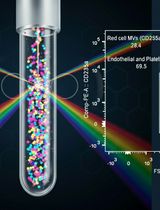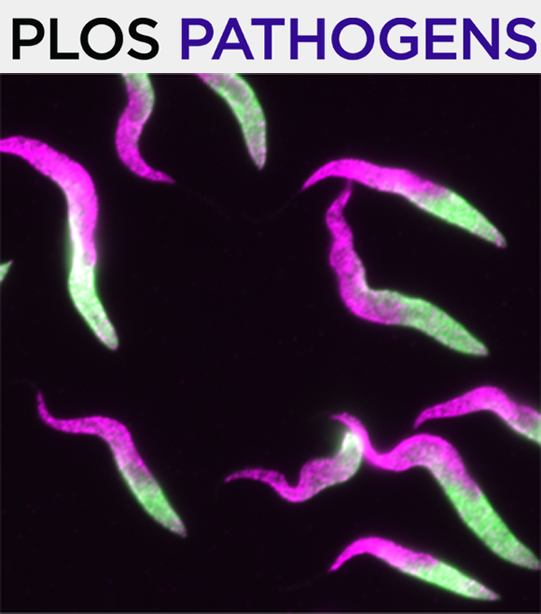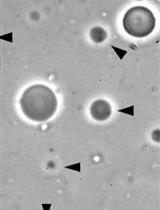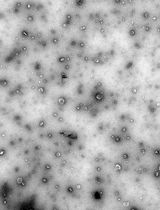- EN - English
- CN - 中文
Fluorescent Labeling of Small Extracellular Vesicles (EVs) Isolated from Conditioned Media
从条件培养基中分离的细胞外小泡的荧光标记
发布: 2022年06月20日第12卷第12期 DOI: 10.21769/BioProtoc.4447 浏览次数: 5574
评审: Alba BlesaSeda EkiciAnonymous reviewer(s)

相关实验方案

外周血中细胞外囊泡的分离与分析方法:红细胞、内皮细胞及血小板来源的细胞外囊泡
Bhawani Yasassri Alvitigala [...] Lallindra Viranjan Gooneratne
2025年11月05日 1335 阅读
Abstract
Extracellular vesicles (EVs), such as exosomes, are produced by all known eukaryotic cells, and constitute essential means of intercellular communication. Recent studies have unraveled the important roles of EVs in migrating to specific sites and cells. Functional studies of EVs using in vivo and in vitro systems require tracking these organelles using fluorescent dyes or, alternatively, transfected and fluorescent-tagged proteins, located either intravesicularly or anchored to the EV bilayer membrane. Due to design simplicity, the fluorescent dye might be a preferred method if the cells are difficult to modify by transfection or when the genetic alteration of the mother cells is not desired. This protocol describes techniques to label cultured cell-derived EVs, using lipophilic DiR [DiIC18(7) (1,1'-Dioctadecyl-3,3,3',3'-Tetramethylindotricarbocyanine Iodide)] fluorophore. This technique can be used to study the cellular uptake and intracellular localization of EVs, and their biodistribution in vivo, which are crucial evaluations of any isolated EVs.
Keywords: Extracellular vesicles (细胞外囊泡)Background
There are several subtypes of extracellular vesicles (EVs), and among them, exosomes are one of the smallest ones, with a size range between 30 nm and 120 nm (reviewed in Théry et al., 2002). Exosomes contain signature molecules, such as tetraspanins (CD9, CD63, and CD81), and are characterized by specific biogenesis originating in the endosomal pathway (reviewed in Huotari and Helenius, 2011). The EVs can carry and transfer various cargo to other cells, including proteins, metabolites, miRNA, and lipids. One of the exciting research areas is the affinity of exosomes to specific tissues and regions, depending on the characteristics of these EVs. Hence, the biodistribution of EVs should be studied, and EV imaging is required to accomplish this goal. Several methods can be used to track EVs in animal cells and tissues. For instance, bioluminescence imaging (BLI) (Gangadaran et al., 2017) is one of the methods with the highest signal-to-noise ratio, but it suffers from low temporal resolution. Magnetic resonance imaging (MRI) (Busato et al., 2016, 2017) can also be used, but this method is associated with low sensitivity and high operation cost. Finally, fluorescence-based imaging of EVs provides a sensitive method with the highest spatial resolution (Corso et al., 2019). Among the fluorescence-based techniques, GFP protein can be expressed with the lowest penetration, which does not allow for noninvasive in vivo imaging, but has high resolution. Near-infrared (NIR) fluorescence imaging using lipophilic dyes, such as DiR [DiIC18(7) (1,1'-Dioctadecyl-3,3,3',3'-Tetramethylindotricarbocyanine Iodide)], can also be used. The two long 18-carbon chains insert into the vesicle membrane avidly, resulting in a negligible dye transfer between EVs. The near IR fluorescent lipophilic carbocyanine DiOC18(7) ('DiR') is weakly fluorescent in water but highly fluorescent and quite photostable when incorporated into membranes. The sulfonate residues incorporated into this DiI analog improve water solubility. Moreover, DiI has an extremely high extinction coefficient and short excited-state lifetimes (~1 nanosecond) in the lipid-rich environment. The DiR shows excitation/emission at 710/760 nm, which, along with its NIR properties, makes this an ideal fluorophore for in vivo EV imaging studies, given the significantly reduced auto-fluorescence from the animal at higher wavelengths (Cook et al., 2015; Somanchi, 2016; Zhao et al., 2021). While there is no perfect method, DiR–based labeling can provide a flexible and low-cost alternative to other methods used for systematic studies of exosomes. This paper describes a technique that uses a lipophilic DiR dye to stain EVs obtained from cell culture, such as cultured macrophages. This approach can be used to track the vesicles for in vitro uptake and in vivo biodistribution studies in animal models.
Materials and Reagents
Polypropylene open-top ultracentrifuge tubes (Beckman Coulter, catalog number: 326823)
Nalgene Rapid-Flow Sterile Single Use Vacuum 0.2 µm Filter 500 mL Unit (Thermo Fisher, catalog number: 566-0020)
Amicon Ultra Centrifugal Filter Ultracell 10,000 MWCO (Millipore Sigma, catalog number: UFC801024)
Syringe Filters, Polyethersulfone (PES) membrane, 0.22 µm (GenClone, catalog number: 25-244)
Greiner Bio-One CellStar μClear 96-Well, Cell Culture-Treated, Flat-Bottom Microplate (Greiner Bio-One, catalog number: 655090)
DiR'; DiIC18(7) (1,1'-Dioctadecyl-3,3,3',3'-Tetramethylindotricarbocyanine Iodide) (Thermo Fisher Scientific, catalog number: D12731)
Pierce Protease Inhibitor Tablets (Thermo Fisher Scientific, catalog number: A32963)
1× Dulbecco’s Phosphate Buffered Saline (DPBS) with Calcium and Magnesium (Thermo Fisher Scientific, catalog number: 14040117)
OptiMEM I Reduced Serum Medium, no phenol red (Thermo Fisher, catalog number: 11058021)
Phosphate Buffered Saline (PBS, 1×), sterile filtered (Thermo Fisher, catalog number: J61196.AP)
DAPI solution (1 mg/mL, Thermo Fisher, catalog number: 62248)
Pierce Protease Inhibitor Tablets, EDTA-Free (Thermo Fisher, catalog number: A32955) (See Recipes)
MicroBCA Protein Assay Kit (Thermo Fisher, catalog number: 23235)
Media containing exosome-depleted fetal bovine serum (FBS) and penicillin/streptomycin (see Recipes)
Control Sample for NanoSight quantification (see Recipes)
Protease inhibitor cocktail (PI) from Pierce Protease Inhibitor Tablets, EDTA-Free (see Recipes)
Equipment
Optima XPN-90 IVD ultracentrifuge (Beckman, catalog number: B10052) with SW 32 Ti swinging-bucket rotor (Beckman, catalog number: 369650)
Sorvall Legend Micro 21R Microcentrifuge (Thermo Scientific, catalog number: 75002447)
Cytation 5 multi-mode reader (Agilent, catalog number: BTCYT5V)
NanoSight LM10 (Malvern Panalytical, catalog number: EOS3085)
Software
GraphPad Prism 9 (GraphPad Software)
Gen5 Software (Agilent)
Procedure
文章信息
版权信息
© 2022 The Authors; exclusive licensee Bio-protocol LLC.
如何引用
Santelices, J., Ou, M., Hui, W. W., Maegawa, G. H. B. and Edelmann, M. J. (2022). Fluorescent Labeling of Small Extracellular Vesicles (EVs) Isolated from Conditioned Media. Bio-protocol 12(12): e4447. DOI: 10.21769/BioProtoc.4447.
分类
细胞生物学 > 细胞器分离 > 胞外囊泡
您对这篇实验方法有问题吗?
在此处发布您的问题,我们将邀请本文作者来回答。同时,我们会将您的问题发布到Bio-protocol Exchange,以便寻求社区成员的帮助。
Share
Bluesky
X
Copy link










